Yellampalli S. (ed.) Carbon Nanotubes - Synthesis, Characterization, Applications
Подождите немного. Документ загружается.


Microwave Absorption Characteristics of Carbon Nanotubes
267
that the bandwith of the modified MWCNTs is much broader than that of unfilled
MWCNTs. The maximum reflectivity (R) is about −12.22 dB at 13.40 GHz and
corresponding bandwidth below −5 dB is more than 5.11 GHz. With the increase of
thickness, the peak of R shifts to lower frequency. The multiple absorbing peaks appeared in
the Sm
2
O
3
-filled CNT composites , which helps to broaden microwave absorbing
bandwidth. Rosa[20] investigated thr multiphase composite materials filled with multiwall
carbon nanotubes (MWCNTs), short nickel-coated carbon fibers and millimeter-long carbon
fibers with various weight fractions . The effective complex permittivity of several
composite samples is measured in the frequency range from 8 GHz to 18 GHz. The obtained
results show that the addition of the MWCNTs into the mixture allows tuning the EM
properties of the composite filled with the short nickel-coated fibers. Numerical simulations
are also performed. The best performing screens in the Ku-band have thicknesses of about
2.13 mm and 1.57 mm, minimum reflection of about -73 dB and -45 dB and bandwidth of 6
GHz and 5 GHz, respectively. Fan[21] prepared CNT/polymer composites and measured
the electromagnetic characteristics and microwave absorption properties of them in a
frequency band of 20-18GHz. The test results demonstrated that the maximum absorbing
value reached 17.61 dB and 24.27 dB with a loading of 4wt% and 8wt% of CNTs and the
correspoding absorbing peak at 7.6 GHz, 15.3 GHz respectively. The dielectric loss was
considered as main attribution to The microwave absorption of CNTs composites rather
than magnetic loss.
Although many progresses have been achieved, the bandwidth and peak of RAM need to be
improved further and enhanced for military and civil applications. In this paper, the
microwave absortion characteristics of CNTs were further investigated. The raw MWCNTs,
doped MWCNTs and aligned MMCNTs were used as microwave absorption agents and
epoxy resin was used as matrix to pepare the composites to measure the properties of
microwave absorption of CNTs.
2. Experiment
2.1 Synthesis of carbon nanotubes
2.1.1 Growth of carbon nanotubes
Carbon nanotubes were grown by the catalytic decomposition of hydrocarbon precursor gas
such as acetylene,ethylene, ethanol or methane.In this investigations, liquified petrolum gas
(LPG) was used as carbon sources. Metal catalysts mainly include nickel, cobalt, iron, or a
combination of them. The metal catalyst nanoparticles can be fabricated by sol-geo, co-
deposition processes. The size of catalyst particles has big impact on the diameters of the
nanotubes that are to be grown. The smaller particle grow smaller diameter of carbon
nanotubes. In the paper, iron was employed as catalyst which play a crucial role in the
nucleation and growth of carbon nanotubes in the thermal chemical vapor deposition (CVD)
process. Nanotubes grow at the sites of the metal catalyst. The carbon-containing gas is
broken apart at the surface of the catalyst particle, and the carbon is transported to the edges
of the particle, where it forms the nanotubes. The substrates of catalyst include diatomite,
MgO or Al
2
O
3
to increase the surface area for higher yield of the catalytic reaction of the
carbon feedstock with the metal particles. The removal of the catalyst support commonly
employed an acid treatment method, which sometimes could destroy the original structure
of the carbon nanotubes. In this investigation, carbon nanotubes themslef were used as
substrates which result in higher purity of as-produced carbon nanotubes. The details of the
MWNTs preparation method [ 22 ] were described elsewhere.

Carbon Nanotubes - Synthesis, Characterization, Applications
268
2.1.2 Growth of aligned carbon nanotubes
Ferrocene was dissolved in solution of xylene used also as the carbon source. The flat quartz
glass substrates were put on the middle of the electrical furnace. The furnace was heated to
about 850 ℃. Argon gas was introduced to the furnace to eliminate air and then a mixture
gas of argon and hydrogen was introduced as the carrier gas. The solution of ferrocene and
xylene was injected into furnace and was vapored. The vapor then went into the reactive
area where the ACNTs grew on surface of quartz glasses.
2.1.3 Preparation of the composites
2.1.3.1 Preparation of MWCNT/epoxy composites
Carbon nanotubes with different loading weight of CNTs were respectively added into
epoxy resin and are were sufficiently mixed by high-speed stirring dispersion and
ultrasonication. The mixture was smeared onto an aluminum plate layer by layer until the
thickness of the composites reached 4mm.
2.1.3.2 Preparation of ACNTs/epoxy composites
The films of ACNTs were peeled off from the quartz glasses. Then the films were put on the
surface of a aluminum plate with size of 180X180mm.and were fixed by epoxy resin to
prepare the samples. After curled, the microwave absorption characteristics of the
composites were measured.
2.2 CNTs characterization
In this work, a FEI Quanta 200 scanning electronic microscopy (SEM) and a Hitachi H-600
transmission electronic microscopy (TEM) were used to observe the structure and
morphology of CNTs. A TG/DTA Pyris diamond was employed for thermogravimetric
analysis to ascertain the purity of carbon nanotubes.
2.3 Microwave absorption characteristics of CNTs
Microwave absorption characteristics of CNT/epoxy composites are measured through
radar absorption materials (RAM) measuring system of arch method reflectivity.
3. Results and discusion
Fig.1 is a TEM image of CNTs and Fig.2 is a SEM image of CNTs. The images demonstrate
the CNTs are multiwalled carbon nanotubes(MWCNTs) and have a diameter of 10-30nm
with a length of about several micrometers. The images also show that the MWCNTs were
entangled with each other to become clusters that are the the most main challenge to meet
for effective industrial applications for most fileds. Specially for composite materials. Fig.3
shows the TEM image of dispersed ACNTs. Fig.4 and Fig.5 show SEM images of Low-
magnifying and high- magnifying SEM image of ACNTs. and Fig.6 is micro-image of
ACNTs shot by common camera. Fig.7 demostrates the top morphology of ACNTs.
Fig.4 and Fig.5 show that ACNTs were vertically grown on the substrates. The growth
oriention are contained each other in growth and they only can vertically grown on the
surface of substrates. So the carbon nanotube arrays were shaped. Fig.6 shows the top of
ACNT film looks like the brushwood. Fig.3 shows that CNTs in ACNTs are multi-walled
carbon nanotubes (MWCNTs). The MWCNTs have a diameter of 30~50 nm.
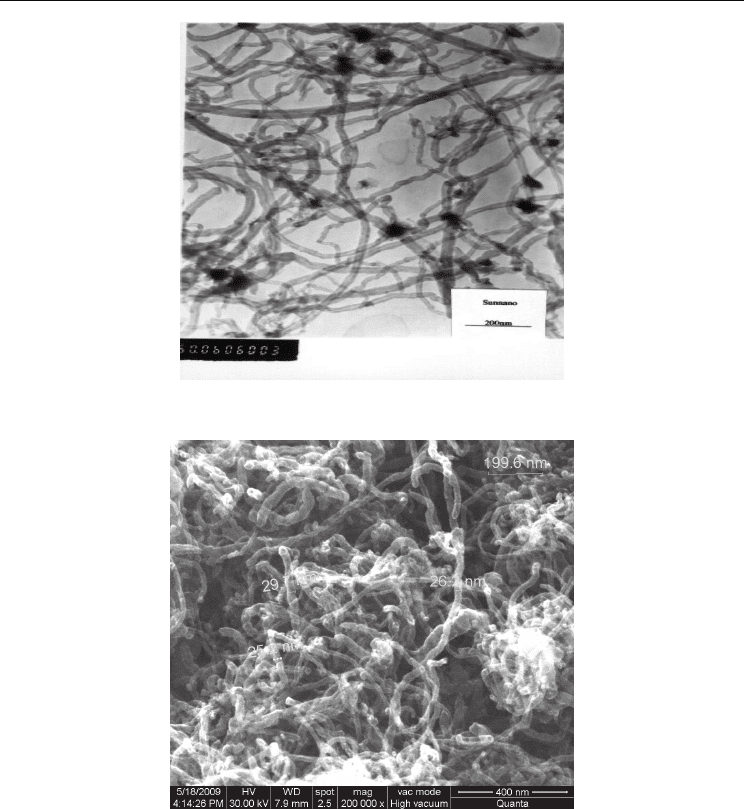
Microwave Absorption Characteristics of Carbon Nanotubes
269
Fig. 1. TEM image of MCWNTs
Fig. 2. SEM image of MCWNTs
The purity of CNTs reaches over 95%.The thermogravimetric analysis (TGA) of MWCNTs
was shown in Fig.8. The MWCNTs have high thermal stability. It can be found that weight
was lost slowly from 50 to 550Ԩ, corresponding to the loss of little water and a few
amorphous carbon. At the temperature range from 550 Ԩto 700, the weight decreased
sharply to 2.20 wt%, indicating that the combustion of the MWCNTs started at 550Ԩ. Also a
thing to note is that the curve slope maintained almost the same value from 550 to 700Ԩ. It
is illustrated that the MWCNTs were combusted at a constant speed, suggesting that the
MWCNTs reached to a high purity at 550Ԩ. After 700Ԩ, the weight of the sample remains
unchanged. The remainders may be assigned to catalyst including 2.20 % iron and
aluminium metal oxides. Therefore, 550Ԩ can be considered as an optimum temperature to
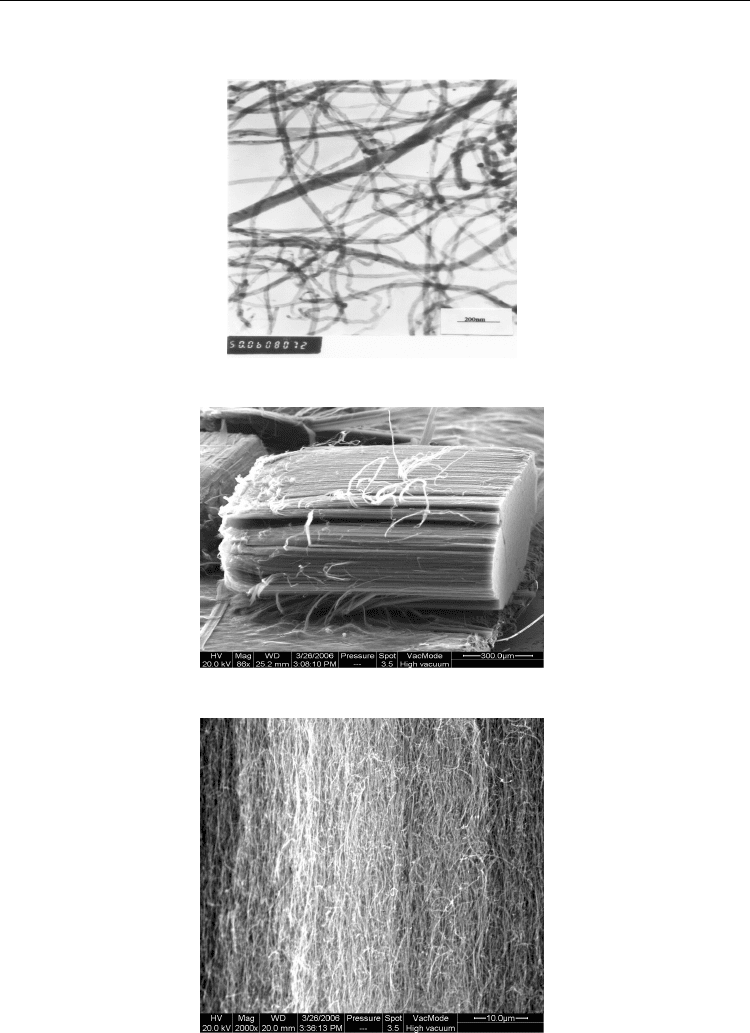
Carbon Nanotubes - Synthesis, Characterization, Applications
270
burn out amorphous carbon particles for CNT purification. The figure demonstrate the
purity of measured CNTs reached 97.80%.
Fig. 3. TEM image of dispersed ACNTs
Fig. 4. Low-magnifying SEM image of ACNTs
Fig. 5. SEM image of ACNTs
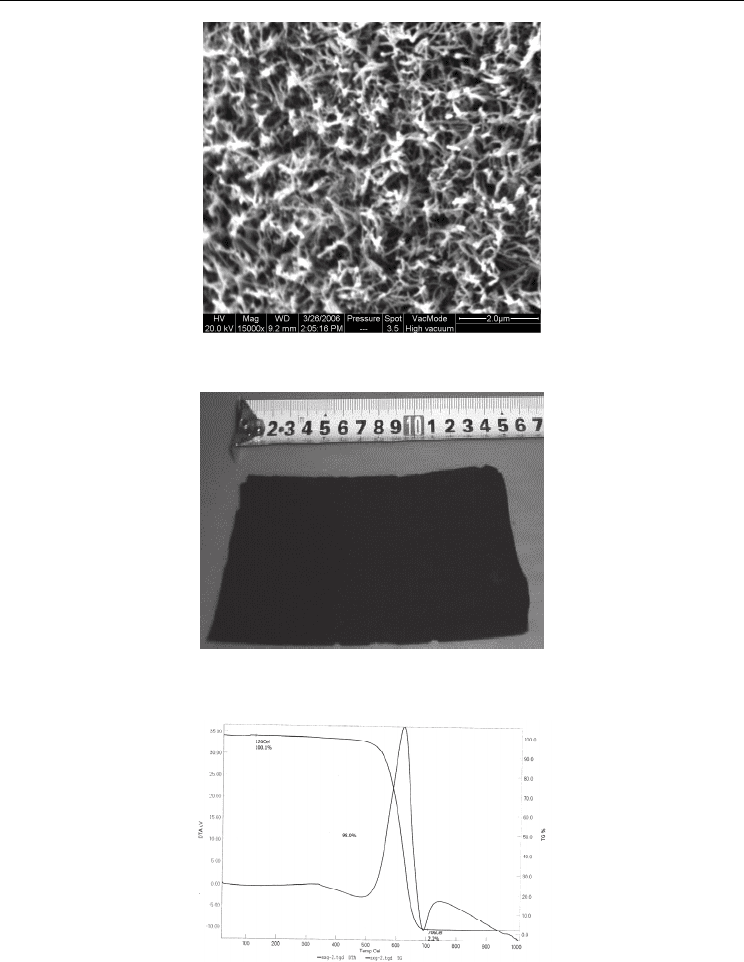
Microwave Absorption Characteristics of Carbon Nanotubes
271
Fig. 6. Top SEM image of ACNTs
Fig. 7. Macro image of ACNTs
Fig. 8. Thermogravimetric curves of MWCNTs
The Fig.9 shows SEM image of cross-section of CNT/epoxy composites. The figures
demostrate the MWCNTs were well dispersed in epoxy resin matrix but some entangled
MWCNTs can still be observed in the epoxy resim matrix.
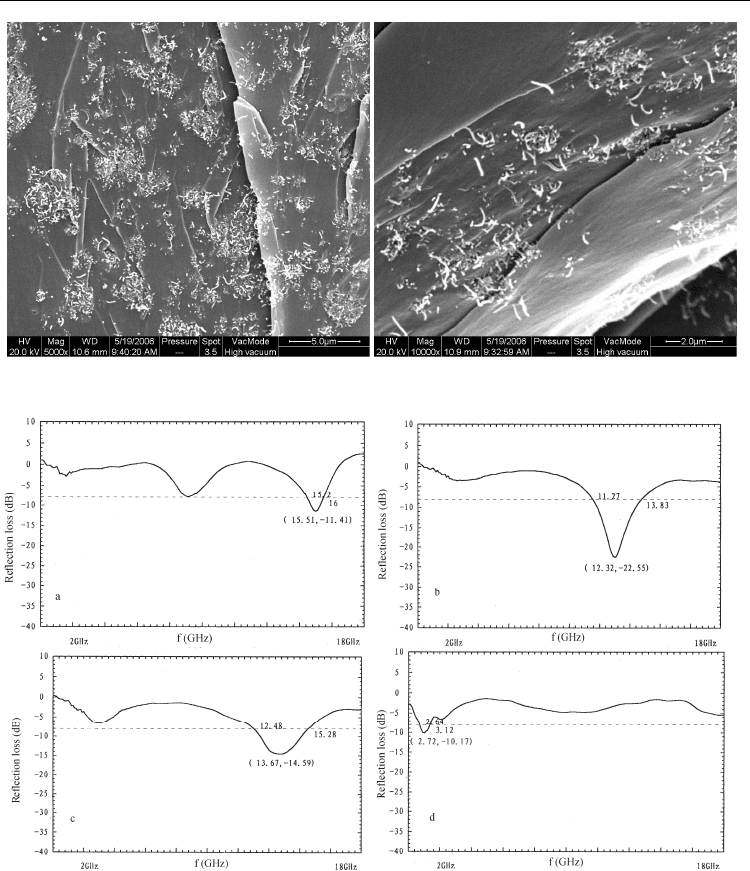
Carbon Nanotubes - Synthesis, Characterization, Applications
272
Fig. 9. SEM image of cross-fracture of MWCNT/epoxy composites
Fig. 10. Microwave absorbing properties of epoxy matrix composites containing CNTs with
different loading of (a)5wt%, (b) 8wt%, (c) 10wt% and (d) 20wt%.
Fig.10 shows the reflection loss curves of different MWCNT/epoxy composites. The figures
of reflecton loss show carbon nanotubes can effectively absorb radar waves in frenquency
band of 2-18GHz.The absorbing peak, absorbing peak value and bandwidth change with
different loading of carbon nanotubes. The wave absorption paprameters were showed in
table.1. The sample b obtained the largest absorbing peak value of -22.55 dB at 12.32 GHz
with a bandwidth of 2.56 GHz(R<-10 dB)and 4.16 GHz (R<-5 dB)respectively.
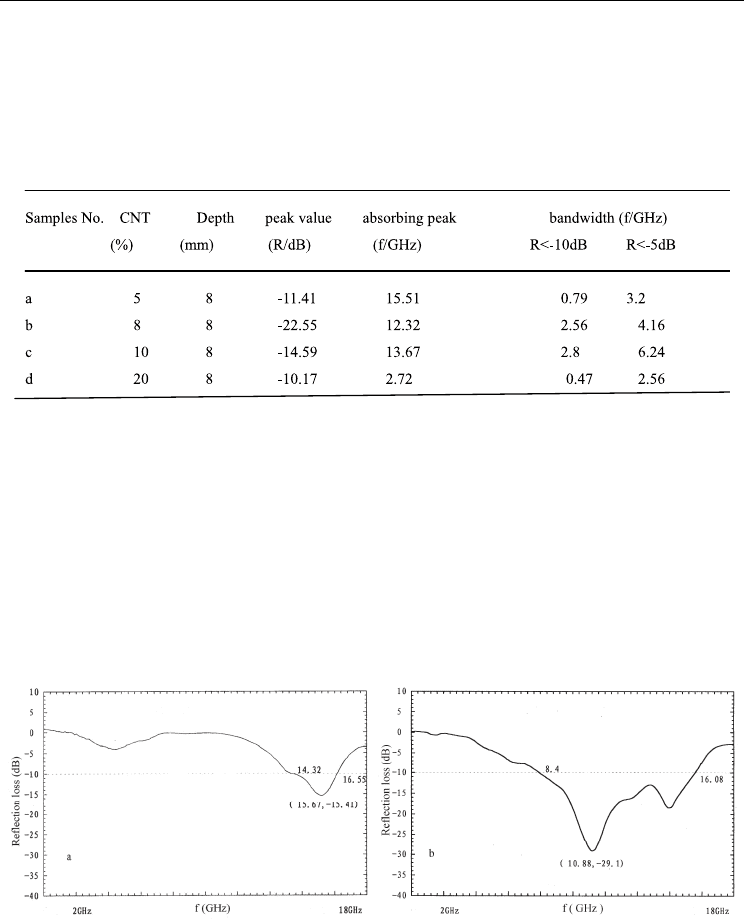
Microwave Absorption Characteristics of Carbon Nanotubes
273
The sample c obtained the largest bandwidth of of 2.80 GHz(R<-10 dB)and 6.24 GHz
(R<-5 dB)respectively. Another important characteristic, as demonstrated in Fig10a,c,d is
double absorbing peaks, The second largest peak value reach -7.73 dB at 9.2 GHz,-6.62 at
4.40 Ghz and -5.39 dB at 17.80 GHz for sample a, c,d. The duble absorbing peaks is a
peculiar properties of carbon nanotubes which can improve wave absorbing properties and
enhance the bandwidth.
Table 1. Radar waves absorbing properties of CNT/EP composites
Fig.11 shows microwave absorption characteristics of rare earth doped MWCNT composites
(a) 5wt% CNT and 1% CeO,and (b) 8wt% CNT and 1% CeO. The Fig.11 indicated the radar
waves absorbing properties of carbon nanotubes were substantially improved after
modification by rare earth oxides. The highest absorbing peak of the sample reachs –29.10
dB at 10.88 GHz and the bandwidth reaches 7.68 GHz(R<-10dB)loaded with 1wt% rare
earth and 8% carbon nanotubes compared with undoped MWCNT with the absorbing peak
value of 12.32dB and bandwidth of 2.80 GHz(R<-10 dB). The peak value increased by
16.87 dB and bandwidth increased by 4.88GHz.
Fig. 11. Microwave absorption characteristics of rare earth dopped MWCNT composites.
Rare earth elements are of great importance in magnetic, electronic, and optical materials
because of the number of unpaired electrons in their 4f shells. The unique electronic, optical
and chemical properties make them useful in radar wave absorption. The rare earth 4f shells
were not fully filled. This results in the magnetic moment. The magnetic moment of rare
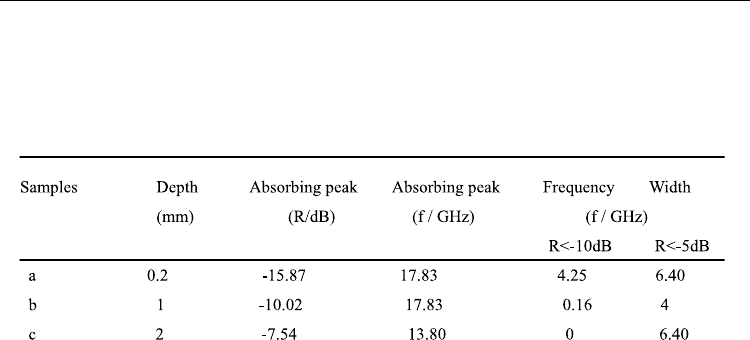
Carbon Nanotubes - Synthesis, Characterization, Applications
274
earth atoms or ions are related with not only the factor g
1
but although angular momentum
J. These unique characteristics enhance largely the microwave absorption of CNTs.
Fig.12 demostrates microwave absorption characteristics of aligned carbon nanotubes with
different film thickness of (a) 20μm, (b) 2mm and (c) 1mm. The microwave absorption
parameters were listed in table2.
Table 2. Microwave absorption parameters of ACNTs
As showed in Fig.4 and Fig.5, the aligned carbon nanotubes were vertically grown on the
substrates in oriention. they are restricted in growth oriention and only can vertically be
grown on the surface of substrates and so the array of carbon nanotubes was shaped. The
carbon nanotubes in array parallels each other and resulted in anisotropy of aligned
carbon nanotubes. Fig.6 shows the top of ACNT films looking like the hassock. This
morphology is similar to jungle structure of radar wave absorption disguise and is
beneficial to microwave absorption[23]. When electromagnetic wave reaches the top
surface of ACNTs, the part was reflected back into air and other enters into ACNT jungle.
The electromagnetic wave was hold in the hassock of ACNTs and was absorbed and
exhausted in repeat reflection.
The microwave absorption curves and absorption parameters of ACNTs show ANTs have
excellent microwave absorption properties in higher band in 2~18GHz. The absorbing peak
and bandwidth change with different thickness of films of ACNTs. The absorption peak of
the sample A reaches -15.87dB at 17.83 GHz and has a bandwidth of 4.25 GHz(R<-10dB)
and 6.40GHz (R<-5 dB). The absorption peak of the sample B reaches -10.02 dB at 17.83
GHz and has a bandwidth of 0.16 GHz(R<-10dB) and 4.00GHz (R<-5 dB). The
absorption peak of the sample C reaches -7.54 dB at13.80 GHz and has a bandwidth of 5.40
GHz (R<-5 dB).
The test results indicate the absorption peak of ACNTs decreases with the increase of
thickness of film of ACNTs. The peak decreases from -15.87 dB (sample A) to -7.54 dB
(Fig.c)。The peak is situated at higher band of 2~18 GHz. This may be resulted from the
increase reflection rate of microwave on thicker film of ACNTs. The microwave
absorption bandwidth of ACNTs also changes with thickness of films of ANTs. The
bandwidth of reflection loss less than -10dB decreases from 4.24 GHz (sample A) to zero
(Fig.c). The bandwidth of reflection loss less than -5dB first decreases from6.40 GHz
(Fig.a) to 4.00 (Fig.b) and then again increase 6.40 GHz (Fig.c). These do not exhibits
obvious trend.
Nanomaterials have a new wave absorption mechanism from the effects of small size,
surface and quanta size. The quanta size effect brings out the breakage of periodic
boundaries and make the characteristics of voice, light, electron, magnet and energetics
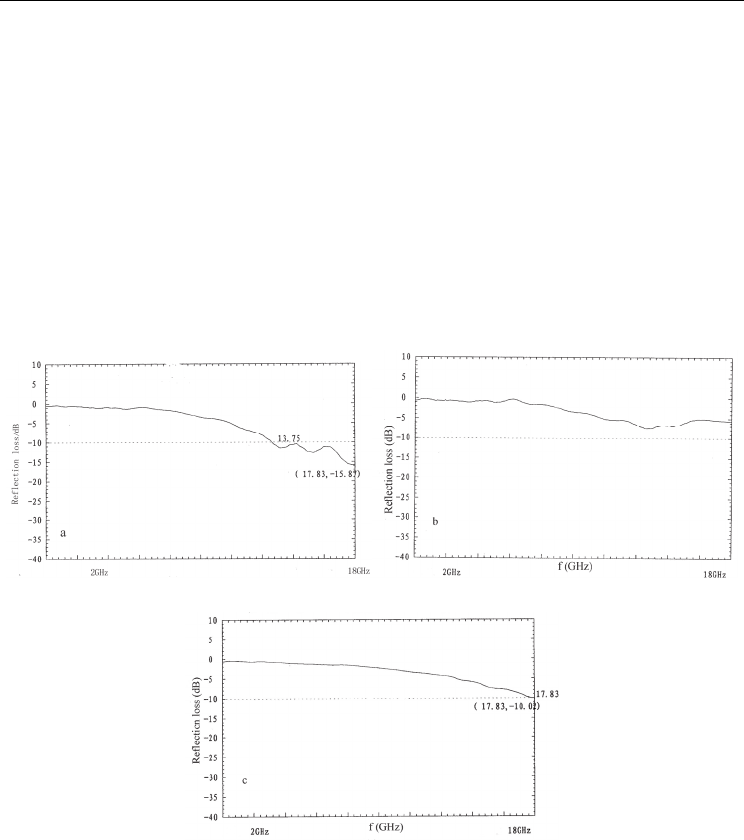
Microwave Absorption Characteristics of Carbon Nanotubes
275
changed , so they substantially enhance the properties of microwave absorption of
nanomaterials. CNTs have vast surface, high rate atoms of surface and substantive hanging-
bonds. These effect of interface polarization and mulriple dispersion improve the
electromagnetic wave absorption of CNTs. The quanta size effect makes energy level of
electrons to be splitted. The gaps of energy just contain microwave energy level (10
-2
~10
-5
eV),and so produces a new way of wave absorption. Further more, CNT has two kinds of
structures including the symmetry and chirality. The chiral structures enhance the radar
wave absorption performance of CNTs. CNTs were dispersed into polymer matrix to form
electrically conductive network in polymer. The energy of electromagnetic waves was also
attenuated in network resistors, which is similar to the resistive type of wave absorption
materials.
Fig. 12. Microwave absorption characteristics of aligned carbon nanotubes with different
film thickness of (a) 20μm, (b) 2mm and (c) 1mm.
Rare earth elements are of great importance in magnetic, electronic, and optical materials
because of the number of unpaired electrons in their 4f shells. The unique electronic, optical
and chemical properties make them useful in radar wave absorption. The rare earth 4f shells
were not fully filled. This results in the magnetic moment. The magnetic moment of rare
earth atoms or ions are related with not only the factor g
1
but although angular momentum
J. These unique characteristics enhance largely the microwave absorption performance of
CNTs.

Carbon Nanotubes - Synthesis, Characterization, Applications
276
4. Conclusion
Summary, carbon nanotubes including multiwalled carbon nanotubes, rare earth doped
carbon nanotubes and aligned carbon nanotubes were investigated for stealth applications.
The reaserch demostrated that carbon nanotubes have good microwave absorption
properties. The rare earth doped carbon nanotubes showed better microwave absorption
properties. CNTs doped with rare earth demonstrate good improvement of microwave
absorption properties. The absorbing peak of the CNTs doped with 1wt% rare earth reached
–29.10 dB at 10.88 GHz and the bandwidth reached 7.68 GHz(R<-10dB)loading with 8%
carbon nanotubes compared with undopped MWCNT with the absorbing peak value of
12.32dB and bandwidth of 2.80 GHz(R<-10 dB). The peak value increased by 16.87 dB
and bandwidth increased by 4.88GHz.
Alinged carbon nanotubes showed good microwave absorption prperties in higher band of
2~18 GHz. The microwave absorption peak value of ACNTs decreased with the increase of
thickness of film of ACNTs. The peak value decreased from -15.87 dB to -7.54 dB. The peak
is situated at higher band of 2~18 GHz. The microwave absorption bandwidth of ACNTs
also changes with the thickness of films of ANTs. The bandwidth of reflection loss less than
-10dB reached 4.24 GHz.
Carbon nanotbes demonstrate big potential in industrial applications for microwave
absorption. The futher investigation was needed to devolop the applications, specailly for
stealth arms.
5. References
[1] Sumio Iijima. Helical Microtubules of Graphitic Carbon. Nature. 1991, 354:56-58
[2] M.R.Falvo, G. J. Clary, R M Taylor, et al. Bending and Buckling of Carbon Nanotubes
Under Large Strain.Nature. 1997, 389:582.
[3] J P Salvetat, J M Bonard, N H Thomson, et al. Mechanical Properties of Carbon
Nanotubes. Appl. Phys. A. 1999, 69: 255-260.
[4] B G Demczyk, Y M Wang, J Cumings, et al. Direct Mechanical Measurement of the
Tensile Strength and Elastic Modulus of Multiwalled Carbon Nanotubes. Material
Science and Engineering .2002, A334:173-178.
[5] Savas Berber, Young-Kyum Kwon, David Tomanek. Unusually High
Thermal Conductivity of Carbon Nanotubes. Phys.Rev.Lett. 2000,84:4613-
4616.
[6] Ebbesen T W, Lezec H J, Hiura H, et al. Electrical Conductivity of Individual Carbon.
Nature. 1996, 382:54-56.
[7] Z K Tang, Lingyun Zhang, N Wang, et al. Superconductivity in 4 Angstrom Single-
walled Carbon Nanotubes. Science. 2001, 292:3462-3465.
[8] SHEN Zeng-min, ZHAO Dong-lin. Study on the Microwave Absorbing Poperty of
Composite Material Containing Carbon Nanotubes with Ni Coating. New Carbon
Materials, 2001,16(1):1-3.
[9] CAO Mao-sheng, GAO Zheng-juan, ZHU Jing. Materials Engineering, 2003,2:34-36.
[10] Haiyan Lin, Hong Zhu *, Hongfan Guo, Liufang Yu. Microwave-absorbing
properties of Co-filled carbon nanotubes. Materials Research Bulletin 43 (2008)
2697–2702.
